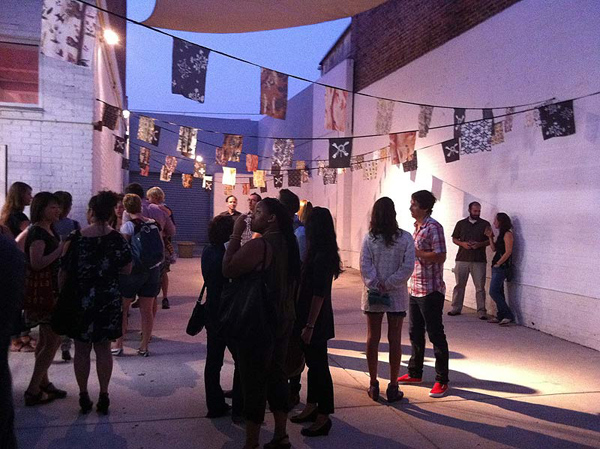 Upcoming solo project at Conner Contemporary in Washington, D.C.
A *GOGO ART PROJECTS SPECIAL INSTALLATION
SEPTEMBER – OCTOBER, 2011
Opening September 10
My recent work has focused on the ‘Lost Colony’ of Elizabethan era colonialism, particularly the formal portraits of Queen Elizabeth I and the explorers and voyagers. The relationship between the costumes, clothing, and material culture of the Elizabethan era to the political and metaphorical outcomes of capitalism and colonialism provide rich artistic fodder in my practice.
I am inspired by the watercolors of John White from the 1580’s, which feature native Algonquins and Secotans (located then in present‐day North Carolina) performing rituals, planting crops, preparing food, and displaying their clothing, and also the Elizabethan privateers and colonists (Sir Walter Raleigh, Sir Francis Drake, etc.) who formed her colonial advisorship. Within the Elizabethan portraits, by painters such as Nicholas Hilliard and Marcus Gheeraerts the Elder, what we see on display is an attentiveness to crafting a public persona, political agenda, and the attendant clues to specific aspects of propaganda in image‐making. The iconography of empire is visible in the globes, crowns, swords and coumns, and also, I would argue, within the patterns of the clothing itself. Contemporary fashion designers such as Alexander McQueen and Vivienne Westwood have mined some of this very material in their recent collections.
Plunder, for Conner Contemporary in 2011, utilizes the courtyard space to exhibit several lines of fabric banners inspired by nautical textile forms. The flags feature decorative paintings appropriated from the clothing on Queen Elizabeth I in her many royal portraits. The paintings are made as works on paper, then digitally scanned and commercially printed with weather‐resistant inks onto fabric. I am interested in how pirate culture was not only the rogue sailors and privateers who plundered other ships for transatlantic trade goods, but also the colonizers who ‘plundered’ North America with the queen’s blessing. This title is meant to point directly at my critical and artistic view of the colonial era, as evinced in my own plundering of the queen’s decorative patterning. Acting as subversive pirate flags, the project will come full circle when versions of the flags are installed in a port in Plymouth, England (where many Elizabethan ships set sail) and on Roanoke Island, North Carolina, where the Lost Colony was based. In Plunder, I have already begun to explore the relationship between costume, class, and economic power.]]>
Upcoming solo project at Conner Contemporary in Washington, D.C.
A *GOGO ART PROJECTS SPECIAL INSTALLATION
SEPTEMBER – OCTOBER, 2011
Opening September 10
My recent work has focused on the ‘Lost Colony’ of Elizabethan era colonialism, particularly the formal portraits of Queen Elizabeth I and the explorers and voyagers. The relationship between the costumes, clothing, and material culture of the Elizabethan era to the political and metaphorical outcomes of capitalism and colonialism provide rich artistic fodder in my practice.
I am inspired by the watercolors of John White from the 1580’s, which feature native Algonquins and Secotans (located then in present‐day North Carolina) performing rituals, planting crops, preparing food, and displaying their clothing, and also the Elizabethan privateers and colonists (Sir Walter Raleigh, Sir Francis Drake, etc.) who formed her colonial advisorship. Within the Elizabethan portraits, by painters such as Nicholas Hilliard and Marcus Gheeraerts the Elder, what we see on display is an attentiveness to crafting a public persona, political agenda, and the attendant clues to specific aspects of propaganda in image‐making. The iconography of empire is visible in the globes, crowns, swords and coumns, and also, I would argue, within the patterns of the clothing itself. Contemporary fashion designers such as Alexander McQueen and Vivienne Westwood have mined some of this very material in their recent collections.
Plunder, for Conner Contemporary in 2011, utilizes the courtyard space to exhibit several lines of fabric banners inspired by nautical textile forms. The flags feature decorative paintings appropriated from the clothing on Queen Elizabeth I in her many royal portraits. The paintings are made as works on paper, then digitally scanned and commercially printed with weather‐resistant inks onto fabric. I am interested in how pirate culture was not only the rogue sailors and privateers who plundered other ships for transatlantic trade goods, but also the colonizers who ‘plundered’ North America with the queen’s blessing. This title is meant to point directly at my critical and artistic view of the colonial era, as evinced in my own plundering of the queen’s decorative patterning. Acting as subversive pirate flags, the project will come full circle when versions of the flags are installed in a port in Plymouth, England (where many Elizabethan ships set sail) and on Roanoke Island, North Carolina, where the Lost Colony was based. In Plunder, I have already begun to explore the relationship between costume, class, and economic power.]]>